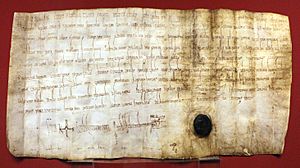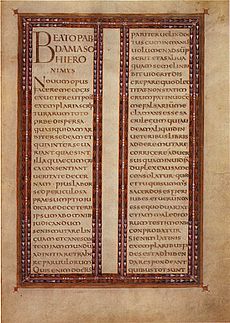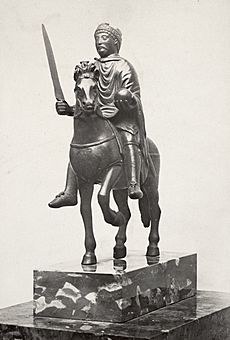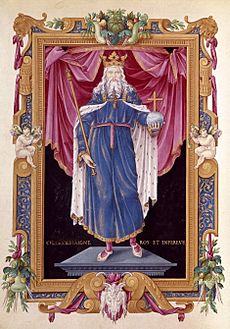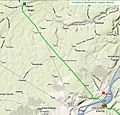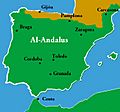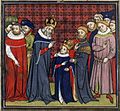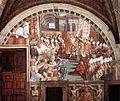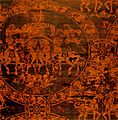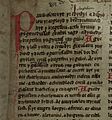Charlemagne facts for kids
Quick facts for kids Charlemagne |
|
|---|---|
| Emperor of the Romans | |
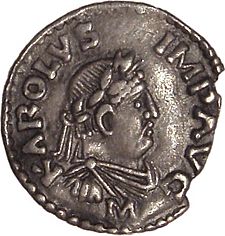
A denarius of Charlemagne dated c. 812–814 with the inscription KAROLVS IMP AVG
(Karolus Imperator Augustus) |
|
| King of the Franks | |
| Reign | 9 October 768 – 28 January 814 |
| Coronation | 9 October 768 Noyon |
| Predecessor | Pepin the Short |
| Successor | Louis the Pious |
| King of the Lombards | |
| Reign | 10 July 774 – 28 January 814 |
| Coronation | 10 July 774 Pavia |
| Predecessor | Desiderius |
| Successor | Bernard |
| Emperor of the Carolingian Empire | |
| Reign | 25 December 800 – 28 January 814 |
| Coronation | 25 December 800 Old St. Peter's Basilica, Rome |
| Successor | Louis the Pious |
| Born | 2 April 747 Liège (Herstal) or Aachen |
| Died | 28 January 814 (aged 66) Aachen, Francia |
| Burial | Aachen Cathedral |
| Spouse |
|
| Issue Among others |
|
| Dynasty | Carolingian |
| Father | Pepin the Short |
| Mother | Bertrada of Laon |
| Religion | Chalcedonian Christianity |
| Signum manus | |
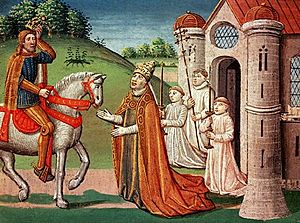
Charlemagne (also known as Charles the Great) was a powerful king of the Franks. He was born around 742 or 747 and died on January 28, 814. He is famous for starting the Holy Roman Empire when he was crowned Emperor in 800.
Charlemagne was the older son of King Pepin the Short. After his father died, Charlemagne and his brother Carloman ruled the Frankish kingdom together. When Carloman died in 771, Charlemagne became the sole ruler. On Christmas Day in 800, Pope Leo III crowned him Emperor in Rome.
Contents
Charlemagne's Life and Reign
The Franks were a Germanic group who had settled in what is now France and parts of Germany. By the 700s, they controlled a large area and protected the Papacy and the Roman Catholic faith. When King Pepin the Short died, his sons, Charlemagne and Carloman, divided the kingdom. Carloman died in 771, making Charlemagne the sole leader of the entire Frankish kingdom.
He became King of the Franks in 768 and King of the Lombards in 774. His crowning as Emperor in Rome in 800 marked the beginning of the Holy Roman Empire. This new empire aimed to be like a second Western Roman Empire. Through many wars, Charlemagne expanded his empire across much of Western Europe.
Charlemagne fought in many wars during his rule. He was known for using his sword, "Joyeuse", in his battles. He successfully conquered Saxony, a feat the Roman Emperor Augustus could not achieve centuries earlier. He also helped convert the Saxons to Catholic Christianity. Charlemagne also encouraged the building of schools so his people could learn.
Charlemagne had many children. His family line, known as the Carolingians, included several important royal families in Europe.
Charlemagne's Death
In his later years, Charlemagne faced challenges and became very sad. He died in 814, leaving his kingdom to his only surviving son, Louis the Pious. The Carolingian family line continued for some time but eventually ended in Germany in 911 and in France in 987.
Important Battles and Campaigns
One of Charlemagne's most significant conflicts was the Saxon Wars. These were a series of campaigns and uprisings that lasted for 33 years, starting in 772. Charlemagne aimed to conquer Saxony during these wars.
How Charlemagne Ruled
Organizing the Kingdom
Charlemagne had the power to rule and command his kingdom. He was the highest judge, made laws, led the army, and protected the Church and the poor. He worked hard to organize his kingdom, the Church, and the nobles around him. Charlemagne is known for many important changes he made, including reforms in money, government, military, culture, and the Church. His time is often called the "Carolingian Renaissance" because of these improvements.
Military Strength
Charlemagne's success in war came from new ways of attacking castles and excellent planning for supplies. Horses were very important for his army. They allowed troops to move quickly over long distances, which was key to building and keeping his large empire.
Money and Economic Changes
Charlemagne played a big role in Europe's economic future. He continued his father's money reforms. He changed the money system from one based on gold to one based on silver. This was partly because there wasn't much gold available.
This change made trade and business simpler by creating a standard money system across his empire. Charlemagne set a new standard called the livre carolinienne. It was based on a pound of silver, which was worth 20 sous or 240 deniers. At that time, only the denier was a real coin; the livre and sou were just ways to count money.
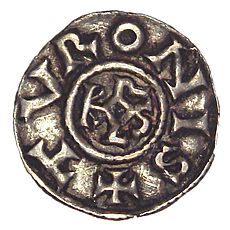
Charlemagne also set up rules for keeping track of money, like incomes and expenses. This system was used across much of Europe.
Jews in Charlemagne's Kingdom
Early in his rule, Charlemagne allowed Jewish people to be involved in money lending. He invited Italian Jews to move to his kingdom and form trading communities. Their trading activities helped the economy in farming areas. Charlemagne even had a Jewish doctor and sent a Jewish person named Isaac as his representative to the Muslim ruler in Baghdad.
Education Improvements
Charlemagne believed strongly in learning and education. His reign is often called the Carolingian Renaissance because of the growth in learning, books, art, and buildings. He learned from the cultures of other countries he conquered, like Spain and Italy. He greatly increased the number of monastery schools and places where books were copied.
Charlemagne loved books and often had them read to him during meals. He enjoyed the works of Augustine of Hippo. His court helped create books for learning basic Latin and church teachings. They also started a royal library with detailed books on language and Christian faith.
Charlemagne encouraged church leaders to translate Christian prayers into local languages. He also wanted them to teach grammar and music. Because of his interest, monks copied many old texts, helping to preserve them. Scholars also wrote more non-religious books on history, poetry, art, music, and law. This led to more private libraries, supported by rich nobles and churchmen.
Many ancient Latin works that we have today were copied and saved by scholars during Charlemagne's time. It's likely that any ancient text that survived until his era is still around today. Charlemagne even studied himself, learning grammar, logic, and astronomy. However, he struggled to learn how to write in his old age.
Church Changes
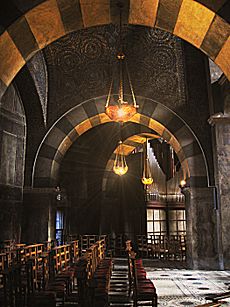
Charlemagne expanded the Church reform program started by his father. He focused on making the Church stronger, improving the skills and morals of priests, and making church services the same everywhere. He also worked to strengthen the basic beliefs of the faith and remove pagan practices. His power covered both the Church and the state. He could discipline church leaders, control church property, and define Christian beliefs.
Writing Changes
During Charlemagne's rule, a new style of writing called Carolingian minuscule was developed. This new script was clearer and easier to read than older styles. Alcuin, who ran the palace school, was a key person in this change. This new writing style spread from Charlemagne's court and later from a famous writing center in Tours.
Charlemagne's Appearance
His Habits

According to his biographer Einhard, Charlemagne ate and drank in moderation. He disliked drunkenness. He enjoyed large feasts only on special occasions. His regular meals usually had four courses, plus roasted meat brought in by his hunters. While eating, he liked to listen to readings or music, especially stories from old times and books by Augustine of Hippo.
When he wasn't working, he enjoyed Christian books, horseback riding, swimming, and hunting. He was a light sleeper and sometimes stayed in bed all day if he had a restless night. During these times, he would call people to his bedroom to settle arguments in his kingdom.
What Language He Spoke
Charlemagne likely spoke a dialect of Franconian, which was spoken in the Rhine region. He also spoke Latin and understood some Ancient Greek.
How He Looked
We know about Charlemagne's appearance from a good description by Einhard. Einhard said Charlemagne was tall and strong. Scientists who studied his skeleton estimated his height to be about 6 feet 4 inches (1.95 meters) or 6 feet (1.84 meters). This made him much taller than most men of his time. He was also described as having a slender build.
His Clothes
Charlemagne wore the traditional clothes of the Frankish people. This included a linen shirt and breeches, a silk-fringed tunic, and hose on his legs. In winter, he wore a coat made of otter or marten skins.
He usually wore a blue cloak and always carried a sword with a golden or silver handle. For special events, his swords were decorated with jewels. He wore fancy clothes and jewels on feast days, but he preferred simple clothing like common people. He only wore Roman clothes twice, when visiting Rome, at the request of the Pope.
His Homes
Charlemagne had many homes and private estates across his kingdom. These estates were managed according to strict rules. A document from the 9th century described one estate, listing livestock, plants, vegetables, and kitchen items. The main house had seventeen rooms for nobles and family members.
Images for kids
-
Charlemagne (left) and Pepin the Hunchback (10th-century copy of 9th-century original)
-
Charlemagne instructing his son Louis the Pious
-
Harun al-Rashid receiving a delegation of Charlemagne in Baghdad, by Julius Köckert (1864)
-
Charlemagne receiving the submission of Widukind at Paderborn in 785, painted c. 1840 by Ary Scheffer
-
Equestrian statue of Charlemagne by Agostino Cornacchini (1725), St. Peter's Basilica, Vatican City.
-
Pope Leo III, crowning Charlemagne from Chroniques de France ou de Saint Denis, vol. 1; France, second quarter of 14th century.
-
The Throne of Charlemagne and the subsequent German Kings in Aachen Cathedral, Germany
-
Coronation of Charlemagne, drawing by Julius Schnorr von Karolsfeld
-
Coronation of an idealised king, depicted in the Sacramentary of Charles the Bald (about 870)
-
The Coronation of Charlemagne, by assistants of Raphael, c. 1516–1517
-
A portion of the 814 death shroud of Charlemagne. It represents a quadriga and was manufactured in Constantinople. Musée de Cluny, Paris.
-
Frederick II's gold and silver casket for Charlemagne, the Karlsschrein
-
One of a chain of Middle Welsh legends about Charlemagne: Ystorya de Carolo Magno from the Red Book of Hergest (Jesus College, Oxford, MS 111), 14th century
-
Emperor Charlemagne, by Albrecht Dürer, 1511–1513, Germanisches Nationalmuseum
See also
 In Spanish: Carlomagno para niños
In Spanish: Carlomagno para niños




